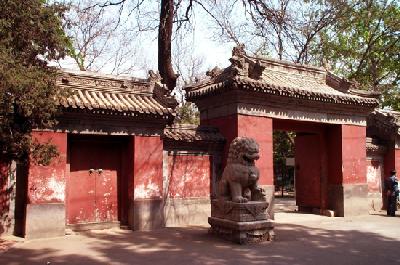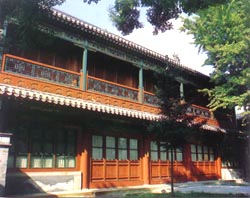The Relic Hall of Chinese Buddhism Books, located inside Fayuan Buddhist Temple with a long-standing history of 1,300 years in Beijing, is a museum of religious relics founded in 1980.

The Hall has collected 2,100 items of relics, including 34 pieces of Class One Relics. In the Dabei (infinite mercy) Hall behind the main hall of the Temple is the Show Room of Different Editions of the Buddhist Sacred Literature through the Ages.
On display are the scriptures handwritten by the people in the Tang Dynasty (618-907), the scriptures written by the people in the Five Dynasties (907-960), the edition of Kaibaozang (name of Buddhist scripture), Sixizang (name of Buddhist scripture), Qishazang (name of Buddhist scripture) of the Song Dynasty (960-1279), the edition of Zhaochengzang (name of Buddhist scripture) of the Jin Dynasty (1115-1234), the edition of Puningzang (name of Buddhist scripture) of the Yuan Dynasty (1271-1368), the edition of Nanzang (name of Buddhist scripture), Beizang (name of Buddhist scripture) and Jiaxingzang (name of Buddhist scripture) and the only edition of Wulinzang (name of Buddhist scripture) of the Ming Dynasty (1368-1644) in the world with a part missing, and the edition of Longzang (name of Buddhist scripture) of the Qing Dynasty (1644-1911).

Also on display are the Beiye scripture (Buddhist scripture written on thetalipot palm) in Sanskrit and the scriptures in the writing of ethnic minority groups such as Xixia, Huihu, Dai, Tibet and Mongolian. On the second floor of the Cangjinglou (a building for storing Buddhist scriptures) are the precious collection of the Beizang, Jiaxingzang and the Longzang of the Qing Dynasty as well as the rubbings of the Tripitaka in Tibetan writing and the complete Fangshan Stone Scripture (Buddhist scripture inscribed on stone found at Fangshan on the suburbs of Beijing).
On the first floor is the Show Room of Buddha Statues through the Ages. Facing the entrance is a 7.4-meter long sleeping Buddha, the longest wood sleeping Buddha in Beijing left from the Ming Dynasty. On both sides are shown a pottery Chuang (a pillar inscribed with Buddha's name of Buddha's scriptures) and a pottery pagoda unearthed from a Liao (916-1125) pagoda in Fangshan in 1977.
If the Liao pagoda, a 21.3 meter high 13-storeyed octagon solid brick pagoda, had not fallen all of a sudden because it had been out of repairs through the ages, the pottery pagoda and the pottery Chuang inside it could not have been discovered by chance. The Chuang is a very special relic not only because it was wrapped inside the Liao pagoda but also because it was made of pottery and in a round shape instead of stone and octagon shape as general Chuangs are.
Around the Show Room are shown the Buddha statues left from the East Han Dynasty (25-220), Three Kingdoms (220-280), Northern Wei (386-534), Sui Dynasty (581-618), Tang Dynasty (618-907), Five Dynasties (907-960), Song Dynasty (960-1279), Liao Dynasty (916-1125), Jin Dynasty (1115-1234), Yuan Dynasty (1271-1368), Ming Dynasty (1368-1644) and Qing Dynasty (1644-1911) with different materials, such as bronze, iron, stone, wood, clay, brick, pottery, porcelain, ivory, and colored glaze.
The most precious of these Buddha statues are the arhat from the Song Dynasty, the Bronze Guanyin (Goddess of Mercy) from the Yuan Dynasty, the tri-colored glazed porcelain Guanyin and the cast-bronze Guanyin with one thousand hands and one thousand eyes from the Ming Dynasty. The Buddha statues left from different dynasties and made with different materials, a superb collection of beautiful exhibits in one hall, are of great artistic value.
The Hall held a Show of Fangshan Stone Scripture Rubbings in Tokyo jointly with the Japanese Buddhism University in October 1987 and delivered a special academic lecture. The important achievements of the scientific researches of the Hall have proved that the stone inscription of the Liao and Jin dynasties is based on the reproduction of Qidanzang as the original Qidanzang was lost long ago. The Hall has published 12 volumes of inscribed scriptures left from Liao and Jin dynasties with photo-offset process.
Further Information:
Address: Fayuan Buddhist Temple, Xuanwu District, Beijing
Tel: 8610-63535798
Fax: 8610-63533966
(China.org.cn May 1, 2005)

